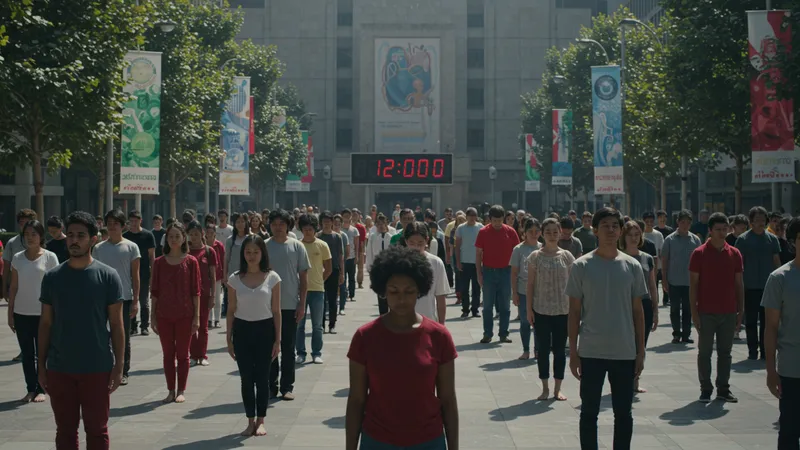

Imagine a world where breathing alone could fuel a movement, a rebellion demanding justice. Sounds impossible, right? Yet, there's groundbreaking evidence suggesting this seemingly mundane act is at the heart of profound societal change.
This isn't just the stuff of sci-fi. With the planet's health and justice in the balance, understanding how our breath connects us globally is critical. The stakes have never been higher as real-time data challenges what we think we know.

Just when you thought activism couldn’t evolve, the world threw another curveball: the power of breath has ignited movements from climate change to justice reform. It's not just about air – it's a symbol of life, resilience, and change. Imagine communities uniting over something as fundamental as the air they breathe, demanding better policies for future generations. But that’s not even the wildest part…
What if the same air keeping us alive could also predict socio-political trends? Sounds far-fetched? More like mind-blowing and statistically backed, according to recent studies. The data's revealing unprecedented links between air quality and social unrest – and it's a game-changer in predictive analytics for policy makers. But there’s a twist that will leave even seasoned experts bewildered…
Discover how ordinary breaths are weaving an extraordinary narrative of justice. Picture communities demanding change, fueled by the invisible force every living being depends on. Breathing may seem simple, but the implications are profound, stirring experts into a flurry of theories. What happens next shocked even the experts...
Breath, the very essence of life, has become a surprising catalyst in shaping political landscapes. Across continents, activists have leveraged breathing as a symbol in their fight against injustice, drawing parallels between air quality, inequality, and resilience. Picture massive marches synchronized not by footsteps, but by the collective rhythm of inhalation and exhalation. This organic unity is both powerful and symbolic, representing a bond stronger than any physical shackle.

On the ground, this has sparked a range of innovative protests where activists “breathe” across borders digitally. Imagine activists in one country, through virtual breathing sessions, supporting their counterparts across seas. This form of protest is not only symbolic but also strategic, showing solidarity in the most fundamental way possible: breathing the same air conceptually. But wait, there’s one more revelation about this breath movement that few have considered…
The environmental impact of such collective consciousness is undeniable. As activists congregate, the focus often shifts to pressing environmental challenges intertwined with justice reform. This union has led to surprising policy changes, where demands for clean air go hand-in-hand with social equity. Communities started installing air quality monitors not just for data but as statements – demanding cleaner environments as a right. What you read next might change how you see this forever.
While governments grapple with citizens who literally breathe down their necks for change, industries are finding themselves re-evaluating their roles in this movement. Corporations are now under scrutiny not just for emissions but for their involvement in broader social dynamics. This shift is turning the tide, with some willing to collaborate in unprecedented ways to support the movement for justice that’s breathing new life into communities globally. But the journey doesn’t end here; there’s another surprising aspect to this story...
In a twist that nobody saw coming, healthcare providers and environmental scientists have joined forces to amplify the justice movement, rallying around the shared concern for public health. Hospitals in affected areas now routinely report on air quality impacts, empowering communities with the knowledge that the quality of their breath directly affects their wellbeing. This collaboration is groundbreaking, binding science with societal change in ways that were only theoretical before.

The synergy between these fields is uncovering correlations previously hidden in plain sight. Doctors now speak at rallies, balancing stethoscopes with megaphones, elucidating the indisputable needs for cleaner environments. Their anecdotes and data push protest narratives beyond emotional pleas to scientifically-backed arguments, achieving new dimensions in activism. However, what if I tell you there’s an even bigger story to this lie-in-the-air realization?
Communities are witnessing reduced respiratory issues as public pressure mounts on industries to cut emissions. The ripple effects are undeniable and profound, offering tangible proof that collective action can yield measurable change. Local governments are now urged to consider environmental impacts in socioeconomic policies, a step often overlooked but brought to the foreground by these unexpected alliances. Yet, there's a side to this burgeoning alliance that many haven’t noticed...
The real surprise lies in how companies once deemed as adversaries are converting into allies. Faced with public pressure and potential legislative changes, some industrial players are pivoting towards eco-friendly practices, unveiling innovations that clean the very air they once polluted. Businesses once resisted now find strategic advantages in embracing change, further showing that the currents of breath-fueled activism are as unpredictable as they are powerful. And the narrative continues, urging us not to underestimate the breath we take for granted...
With the dawn of breath-centric activism, technology has been pivotal in translating the ephemeral into actionable insight. Real-time air quality monitors have emerged as a staple for communities championing environmental justice. These tools demystify the air we breathe, offering transparency and igniting impactful campaigns. People are no longer just passive recipients of air quality reports; they are actively harnessing data to drive changes and hold authorities accountable.

The excitement doesn’t stop at data collection. People are employing innovative apps that let them visualize and share personal air data. The public's newfound capability to track air quality rewrites narratives, turning abstract numbers into stories fueling immediate action. With sensors becoming more affordable, communities are empowered to demand clean air with informed confidence. Yet, there's a tech tool underutilized that could revolutionize these efforts even further...
Social media platforms have become unexpected critique sites where discussions on air bring communities together. Hashtags serve as digital town squares, amplifying voices while platforms stand as allies, using their algorithmic reach to boost crucial messages. The intersection of data transparency and widespread communication is redefining how movements gather momentum and drive legislative demands. But are we truly tapping into the full potential of this digital alliance?
The answer is partially hidden in the technological horizon, with early adopters already testing AI to predict air trends and social movements before they peak. This future-thinking tool can enhance activists’ ability to pre-emptively counter injustices. If vigilant, the movement could evolve, growing less reactive and more visionary, transforming whispers of reform into roars for absolute justice. And that's not all; another formidable alliance looms on the horizon that could be game-changing…
The expression of air through art has unveiled profound avenues in the justice movement. Artists depict the invisible, raising awareness about the air quality we share. Exhibitions and installations capture this struggle, transforming cities into breathing canvases. These artworks don't just raise awareness; they challenge perceptions, creating visceral experiences that stir emotions and inspire action.

Art has proven a gateway to empathy, with exhibitions showing the ramifications of air pollution not as data, but as a lived-and-breathed experience. People leave these shows with a renewed sense of urgency, transformed by beholding the beauty within the struggle depicted artistically. Artists are turning abstract campaigns into tangible, breathing experiences, but there’s an artistic medium that brings a fresh perspective not yet fully appreciated...
Theatre’s also finding its breath with activists staging performances to highlight the plight of communities suffocated by invisible pollutants. These productions elevate the narrative by engaging audiences viscerally, leaving lasting impressions that mere statistics cannot. Ghettos and palaces alike echo with the sounds of shared breath, unfamiliar yet united in these theatrical calls for justice. But wait until you see how this breath-taking art extends beyond traditional media…
With participatory installations in parks, citizens are invited to breathe as a collective act of demand. These moments of collective inhalation stretch beyond performance, temporarily transforming public spaces into arenas of advocacy. The unity cultivated in these settings transcends aesthetics, forging deeper connections among participants and spectators alike. This artistic rebellion is quietly transforming cities worldwide, and there's another creative revolution underway that might upend all current expectations…
The breath-fueled justice movement is slowly weaving a tapestry of global solidarity, with individuals and societies demanding a better world, one breath at a time. This isn't just an isolated battle; it’s shaping up to be the unifying force bringing disparate movements together under one powerful symbol. Picture an international moment of silence – not as a sign of tribute, but as a powerful pause that generates dialogue and shines a light on shared struggles.

International platforms that were once arenas for trade and politics are recognizing the power of this simple yet profound act. Conferences now feature pause sessions, where participants collectively breathe, metaphorically aligning on issues of justice and environmental integrity. This symbolic gesture is evolving into an effective tool for setting agendas and commemorating strides towards justice. But could such a unified breath hold the potential to redefine these platforms’ roles even further?
Nonprofits, witnessing this phenomenon, are reimagining traditional fundraising and community-building activities. Rather than formal dinners or walkathons, groups are organizing 'Breath-a-thons', encouraging communities to invest in their air quality and socio-political health. These events foster unity and spark new dialogues on global health, while engaging participants in a revolutionary way that brings charity and activism together. Could these events mark the transformation of philanthropy as we know it?
As stories trickle through digital streams and into hearts, the message becomes clear: this won’t be a fleeting trend. As breathing becomes synonymous with action, the call for justice sounds ever more resonant. This fight isn’t just about air quality; it's about everyone’s right to breathe freely, and this will require the collective effort of all. There's another layer to this cause that's poised to take the conversation to unparalleled heights, though – and that's the breath of hope we've yet to explore…
The phenomenon of breathing isn’t just political; it’s engrained in the scientific community’s consciousness now more than ever. Each breath carries countless particles, mysteries waiting to be uncovered, and researchers have begun tapping into the potential of these particles to predict health outcomes. This knowledge frames breath not simply as a biological necessity but as a tool for justice, revealing disparities while guiding policy reforms with data-backed interventions.

Research is unearthing potential links between air pollution's microscopic predators and larger socio-political trends. The implications are vast: better understanding these links could not only enhance the fight against pollution but also reveal hidden pathways through which inequality persists. This forms the backbone of a burgeoning field blending technology and activism in unprecedented ways, but there’s another scientific revelation that could completely pivot the narrative...
Environmentalists are thrilled to discover the impact of trees in this complex dance of chemistry and activism. Urban forestry projects are maximizing the potential of nature to neutralize toxins and foster community well-being. These initiatives create more than green spaces; they’re crafting pockets of hope thriving against the concrete harshness of urbanization. But what if trees aren’t just passive components of the ecosystem? This might be truer than you think...
Emerging practices explore revolutionary ideas of bioengineering, pushing boundaries where trees are genetically enhanced to absorb more pollutants and release purer air. This approach, while contentious, could become a crucial factor in city planning and environmental justice strategies. The scientific grounds reveal one truth: the solution lies not just in reducing harm but in harnessing nature's symbiosis with breath. Yet another mystery is being unraveled, questioning our understanding of nature’s breath-related capabilities...
Beyond ceaseless data and digital pulses, there's another quieter force at work in the air justice movement: the enduring rhythm of nature. Through simple immersion in natural settings, communities are reclaiming their right to breathe freely, therein finding a sense of healing and collective welfare that goes beyond mere statistics. This resurgence allows people to reconnect with their roots while counterbalancing the urban austerity that often dominates these debates.

The transformative power of incorporating nature into activism is being realized in community-driven efforts to reclaim biodiverse landscapes. Urban expansion faces an enduring challenger: the people striving to replenish the greens and blues of their planet. This movement is quieter yet resolute, promoting environment as integral to justice. In these sanctuaries of breathing, plants and people find collective restoration, but there's an even more radical idea taking shape in activism, linking nature more deeply...
Therapy circles have begun exploring the power of focused breathing exercises, often conducted in natural settings as both protest and healing. This convergence of mindfulness and environmental advocacy is an emerging heart of the movement. It offers an introspective approach to activism, where individuals draw collective strength from tranquility and mindfulness. Could nature’s ambient rhythm serve as a silent protest against injustice? It seems it very well could...
The revival of indigenous methodologies in breathing techniques is inspiring deeper connections with both the natural world and ancestral wisdom. These practices demonstrate a sustainable, holistic alternative to modern solutions, bridging tenants of the past with the demands of the present. What participants find is that nature’s breath delivers both serenity and solidarity – a poignant and potentially transformative combination. But there’s an untapped potential in this healing practice that is about to surface…
Recently, the climate justice movement found a new ally: the courtroom. These legal arenas, long the domain of policy experts and legislators, are now welcoming grassroots activists armed with data on air quality and health disparities. In groundbreaking cases, the same institutions once perceived as hurdles are becoming platforms for airing grievances and demanding systemic change. This shift promises to bring rejuvenated potency to environmental activism through deliberate legislative change.

Litigation has become a defining strategy for communities pushing for accountability. The leverage of legal precedent lends weight to their causes, transforming courtroom victories into rallying cries. Local governments are being held to account in unprecedented ways, creating a ripple effect that empowers communities far beyond the plaintiff's city limits. Yet the impact of climate cases isn’t just litigation – they’re pitting justice against convention, with surprising results yet to unroll…
The role of non-profits and legal watchdogs has been paramount in crafting compelling narratives and coordinating resources. Their advocacy doesn’t stop with the winning of a case; it echoes in halls and social media, cultivating a broader discourse of justice that inspires further reform. Their influence acts as a beacon for change, guiding other communities to harness laws as tools for air-related justice. Are we witnessing the rebirth of grassroots activism through such court-driven paradigms?
Moreover, cities are beginning to adapt, strategizing new ways to integrate legal outcomes into broader policies on sustainability and urban planning. These proactive shifts suggest that a foundational change may be in progress, driven by those who've experienced injustice firsthand. As laws evolve to reflect community needs, could this be the blueprint for a transformative era in legal activism? The truth lies in the unfolding balance between legislation and breathing justice, and there’s yet another wheel turning that could define this momentum…
We delve back into the impressive role of technology, emerging unabated as an indispensable ally in air justice. New tech isn't just informing; it's transforming mainstream activism into a data-driven, efficient pursuit. The rapid innovation crossing the realms of AI, IoT, and community collaboration reshapes how justice dialogues are crafted, driven by relentless data transparency and technological accessibility for all.

Citizen scientists deploy cutting-edge wearable tech, empowering them to monitor air quality invasively, while AI algorithms deftly detect community patterns unobserved by the human eye. Real-time visualizations reflect daily our invisible struggles, ensuring no activist stands alone in data sophistication. But one tech development promises an unexpected pivot in this landscape, one that could rewrite the narrative of activism...
Through AI simulations, communities can project decades into their ecosystem's future confronting pollution’s long-term impacts. Embracing predictive analytics, activists armed with indisputable projections now approach policymakers with irrefutable foresight. This momentum marks a substantial intertwining of AI with activism, unleashing immersive possibilities in justice seeking. But there’s another angle here, one that might defy expectations...
Repurposing big data for accountability extends beyond awareness to policy-making, heralding a recalibration in global dialogues. The interaction between data and environmental activism is reshaping accountability for companies and governments alike, as transparency breeds responsibility. Could this be the enduring imprint technology leaves in the pursuit of justice? Yet, the story of data refinement grows deeper, teasing at undiscovered layers within its activist potential...
The most surprising evolution in the breath-powered fight for justice is policy change. Unlike isolated legislations of the past, new policy frameworks are integrating air quality considerations directly into public jurisdiction. For the first time, we see governments crafting dynamic policies tightly integrating environmental imperatives with economic and social parameters.

This shift demystifies policy formulation, involving citizen stakeholders in unprecedented deliberations. Townhalls transform into collaborative epochs, where citizens lobby for accessible, equitable air standards. The dynamic interplay between citizen input and policy mandates nurtures unprecedented growth grounded in grassroots activism. Yet, as participatory policies redefine activism, an overlooked facet emerges: might this be our pathway toward true systemic transformation?
Innovative urban design evaluations prioritize the health benefits stemming from improved air quality and environmental access within community proposals. Eco-design now meets equity at the planning table, advocating for sustainable outcomes. The result is thriving communities, where breath translates into substance through legislations rooted in justice and viability. Could these developments shelve our old, uncoordinated methods for good?
Emerging dialogues focus not just on symptomatic relief but on proactive resilience planning, radically extending justice dialogues further into resilience thinking. As policies adapt to include drastic air improvement commitments, we edge closer to long-term justice. The movement’s pulse quickens, capturing the imagination and leading to anticipatory models of community integrity. The endeavors translate into cities crafting policies not just for the present but with a vigilant eye focused on synchronicity for justice. Yet, there’s another environmental layer waiting to be unraveled in this tale...
A critical frontage breaking through the breath-related justice paradigm is its economic evaluation. The fiscal health of regions shows impressive correlations with air quality, leading to sustainable transitions and socio-economic well-being blooming side by side. Safer, cleaner environments aren't peripheral anymore but vital to economic growth and community vitality.

Emerging models recognize clean air as economically profitable, transforming renewable energy from a mere optional policy to a non-negotiable economic growth component. Investments flow into sustainable enterprises as competitiveness shifts in perspective, with the revenue streams from the green economy turning all eyes toward them. But the real drive here is something else: economic equity sparked by endless breath...
Breath equity evolves into a currency reshaping livelihoods, pushing governments to integrate sustainable policies, lured by both their socio-economic benefit and long-term promise. Public health numbers rejoice while pollutive yield begins to yield, flipping old paradigms into financially celebrated new normals. Unexpectedly, air no longer translates just to existence but blossoms into thriving livelihoods and emancipation. Still, there’s another chapter emerging from environmentally-conscious economics...
Strategic international partnerships reinforce economic air literacy, valuing nature’s intangible assets like never before. Nations engage competitively, inspired by the potential of harmonious production coupled with just policies to embolden comparative advantages. Will air justice unlock your economy's full earning potential? With economies adapting to breathe once again, ensuring justice in the air, tapping into the economic facet will necessarily emerge as equally impactful in the holistic spectrum of justice endeavors...
The global air justice narrative isn't just about confronting adversity; it's also about stories of renewal and enduring legacies. Communities facing simultaneous health and environmental peril are finding strength in unity and innovation. In response to systemic injustice, grassroots movements usher in self-starting resilience projects often overlooked by traditional power brokers.

These community-driven efforts reflect a rich tapestry of resourcefulness where local knowledge and experiences bestow communities with resilience tools, reimagining their specific societal fabric. Through cooperative spaces and resilience networks, neighborhoods knit the bonds of justice via shared goals and sustainable ethos. But beyond local endeavors, something larger pivots these movements toward broader objectives...
A spirited revival of cultural practices brings indigenous breathing techniques to mainstream discourse, offering profound insights into living in harmony with nature. These rich philosophies strengthen collective resolve, inspiring innovative methodologies extending beyond borders and timelines. Breathing comes full circle as a life force, embroiling diverse heritage in a collective future. Yet, there's another unfolding instance of community-driven justice sparking unanticipated results...
Technological adaptations cleverly fill gaps, where communities embrace low-cost solutions to mitigate their air-related challenges. Community tech start-ups, leveraging open-source, have become healing fortresses, crucial to combating far-reaching pollution. These adaptations and technologies breathe fresh hope into the solidarity journey, threading a journey of resilience and fortitude. As the world changes, the stories of ordinary people fighting for air echo as proud testaments to human perseverance driven by justice, eagerly presaging the subsequent chapters of life imbibed afresh by justice-seeking narrative.
As the air justice movement grows, emerging practices transition from reactive to proactive strategies. Organizations worldwide excel in creating nimble, adaptable campaigns initiated through deep understanding and targeted impacts. An era of efficacy begins, marking the drive for justice not just as an ambition but an attainable result. What was once perceived merely as environmental concern has accelerated into vast horizons of justice manifestation.

Encompassing multi-pronged approaches ensure that the full spectrum of consequences is addressed, propelling vast-influencing transformations. Prioritizing proactive over reactive methodologies ensures that infrastructures remain robust and communities resilient. The breadth and depth of these initiatives embrace both prompt efficacy and long-term work highlighting multiple foresights. Yet, such robust strategies might have another key objective unearthing strategic justice wisdom...
Consumer lifestyles, once dictated by myopic trends, face a poignant transformation marked by conscious choices driving brand accountability and product evolution. The consumer palate for justice intensifies, ensuring brands realign with transformative expectations through responsibly sourced products. Could this epoch be the juncture where responsibility coexists with commerce? Allegiances shift, captivated by justice-permeated ethics, challenging past commercial paradigms with intentional essence.
Embracing a systematic outlook across all sectors, the drive for breakthrough justice consolidates in strategies cementing policies, social contracts, and operational frameworks. Systemic integration embraces complexity across boundaries, transferring successful strategies globally. Yet, as the wind of justice unfurls diverse solutions to issues, an overlooked facet emerges: the individual's placement within these evolving societal contracts demands introspection, forming the catalyst for the most authentic settings of justice aspirations...
As the air justice movement draws breath for its next leap, it’s just the beginning. Every breath galvanizes new voices in the ongoing narrative for justice, fostering connections spanning continents, language, and culture. The fight isn't solely in protecting; it's about fostering a legacy of care and conviction for generations to come. The currents of change resonate, echoed profoundly through global consciousness.
We stand united, challenged to make justice more than a fleeting ambition, but a living principle. Embrace this powerful movement – share these stories, plant seeds of change, strategize the next actions, and fortify the breath for collective advancement. Our planet calls; let us answer with each inhale and exhale, etching the indelible legacy of resilience into history, breathing life anew into justice.